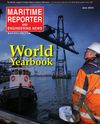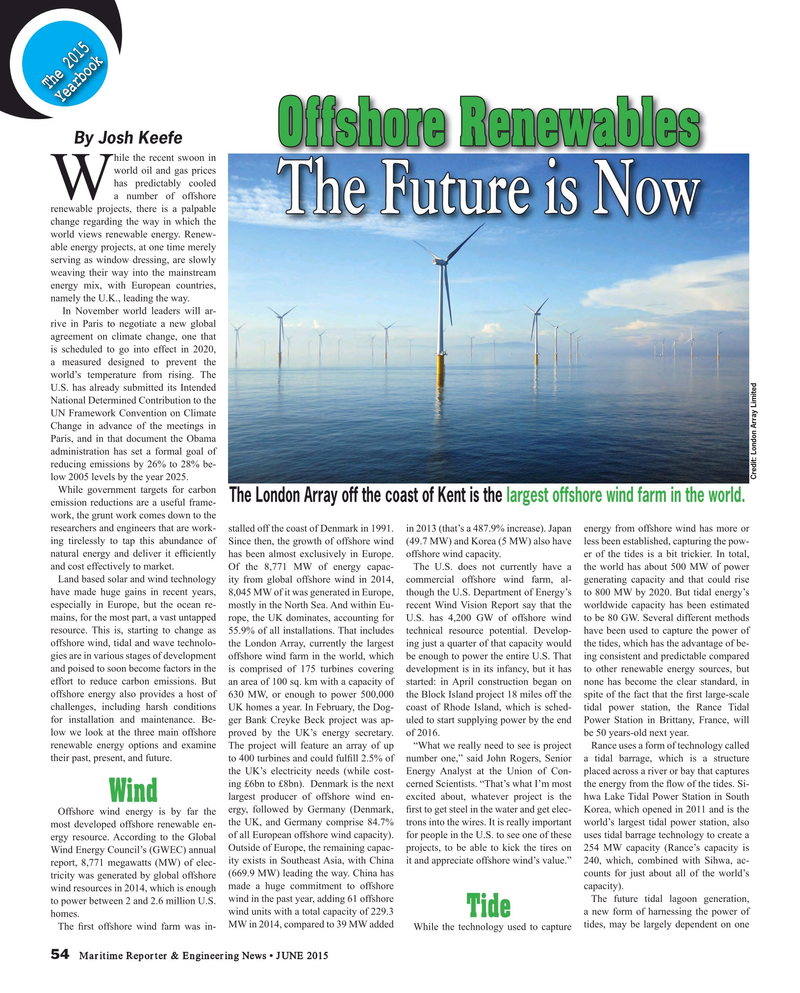
Page 54: of Maritime Reporter Magazine (June 2015)
Annual World Yearbook
Read this page in Pdf, Flash or Html5 edition of June 2015 Maritime Reporter Magazine
The 2015 The 2015
YearbookYearbook
By Josh Keefe
Offshore Renewables Offshore Renewables hile the recent swoon in world oil and gas prices has predictably cooled
Wa number of offshore renewable projects, there is a palpable
The Future is NowThe Future is Now change regarding the way in which the world views renewable energy. Renew- able energy projects, at one time merely serving as window dressing, are slowly weaving their way into the mainstream energy mix, with European countries, namely the U.K., leading the way.
In November world leaders will ar- rive in Paris to negotiate a new global agreement on climate change, one that is scheduled to go into effect in 2020, a measured designed to prevent the world’s temperature from rising. The
U.S. has already submitted its Intended
National Determined Contribution to the
UN Framework Convention on Climate
Change in advance of the meetings in
Paris, and in that document the Obama administration has set a formal goal of reducing emissions by 26% to 28% be-
Credit: London Array Limited low 2005 levels by the year 2025.
While government targets for carbon
The London Array off the coast of Kent is the largest offshore wind farm in the world.
emission reductions are a useful frame- work, the grunt work comes down to the researchers and engineers that are work- stalled off the coast of Denmark in 1991. in 2013 (that’s a 487.9% increase). Japan energy from offshore wind has more or ing tirelessly to tap this abundance of Since then, the growth of offshore wind (49.7 MW) and Korea (5 MW) also have less been established, capturing the pow- natural energy and deliver it ef? ciently has been almost exclusively in Europe. offshore wind capacity. er of the tides is a bit trickier. In total, and cost effectively to market. Of the 8,771 MW of energy capac- The U.S. does not currently have a the world has about 500 MW of power
Land based solar and wind technology ity from global offshore wind in 2014, commercial offshore wind farm, al- generating capacity and that could rise have made huge gains in recent years, 8,045 MW of it was generated in Europe, though the U.S. Department of Energy’s to 800 MW by 2020. But tidal energy’s especially in Europe, but the ocean re- mostly in the North Sea. And within Eu- recent Wind Vision Report say that the worldwide capacity has been estimated mains, for the most part, a vast untapped rope, the UK dominates, accounting for U.S. has 4,200 GW of offshore wind to be 80 GW. Several different methods resource. This is, starting to change as 55.9% of all installations. That includes technical resource potential. Develop- have been used to capture the power of offshore wind, tidal and wave technolo- the London Array, currently the largest ing just a quarter of that capacity would the tides, which has the advantage of be- gies are in various stages of development offshore wind farm in the world, which be enough to power the entire U.S. That ing consistent and predictable compared and poised to soon become factors in the is comprised of 175 turbines covering development is in its infancy, but it has to other renewable energy sources, but effort to reduce carbon emissions. But an area of 100 sq. km with a capacity of started: in April construction began on none has become the clear standard, in offshore energy also provides a host of 630 MW, or enough to power 500,000 the Block Island project 18 miles off the spite of the fact that the ? rst large-scale challenges, including harsh conditions UK homes a year. In February, the Dog- coast of Rhode Island, which is sched- tidal power station, the Rance Tidal for installation and maintenance. Be- ger Bank Creyke Beck project was ap- uled to start supplying power by the end Power Station in Brittany, France, will low we look at the three main offshore proved by the UK’s energy secretary. of 2016. be 50 years-old next year. renewable energy options and examine The project will feature an array of up “What we really need to see is project Rance uses a form of technology called their past, present, and future. to 400 turbines and could ful? ll 2.5% of number one,” said John Rogers, Senior a tidal barrage, which is a structure the UK’s electricity needs (while cost- Energy Analyst at the Union of Con- placed across a river or bay that captures ing £6bn to £8bn). Denmark is the next cerned Scientists. “That’s what I’m most the energy from the ? ow of the tides. Si- largest producer of offshore wind en- excited about, whatever project is the hwa Lake Tidal Power Station in South
Wind
Offshore wind energy is by far the ergy, followed by Germany (Denmark, ? rst to get steel in the water and get elec- Korea, which opened in 2011 and is the the UK, and Germany comprise 84.7% trons into the wires. It is really important world’s largest tidal power station, also most developed offshore renewable en- ergy resource. According to the Global of all European offshore wind capacity). for people in the U.S. to see one of these uses tidal barrage technology to create a
Wind Energy Council’s (GWEC) annual Outside of Europe, the remaining capac- projects, to be able to kick the tires on 254 MW capacity (Rance’s capacity is ity exists in Southeast Asia, with China it and appreciate offshore wind’s value.” 240, which, combined with Sihwa, ac- report, 8,771 megawatts (MW) of elec- tricity was generated by global offshore (669.9 MW) leading the way. China has counts for just about all of the world’s wind resources in 2014, which is enough made a huge commitment to offshore capacity). to power between 2 and 2.6 million U.S. wind in the past year, adding 61 offshore The future tidal lagoon generation, wind units with a total capacity of 229.3 a new form of harnessing the power of homes.
Tide
MW in 2014, compared to 39 MW added While the technology used to capture tides, may be largely dependent on one
The ? rst offshore wind farm was in- 54 Maritime Reporter & Engineering News • JUNE 2015
MR #6 (50-57).indd 54 MR #6 (50-57).indd 54 6/9/2015 3:20:58 PM6/9/2015 3:20:58 PM

 53
53

 55
55
